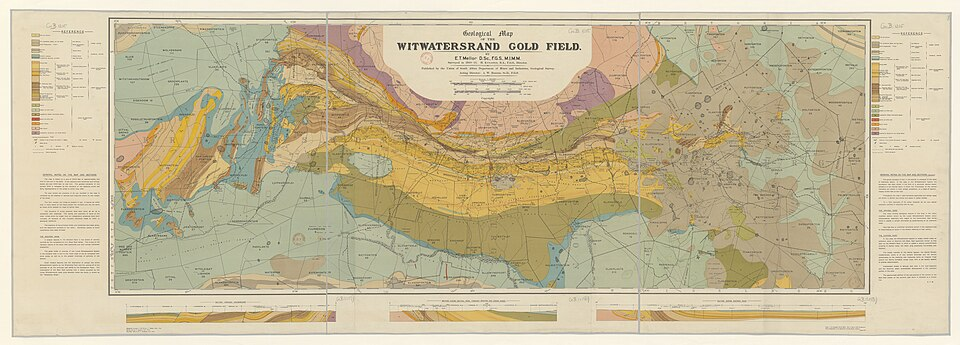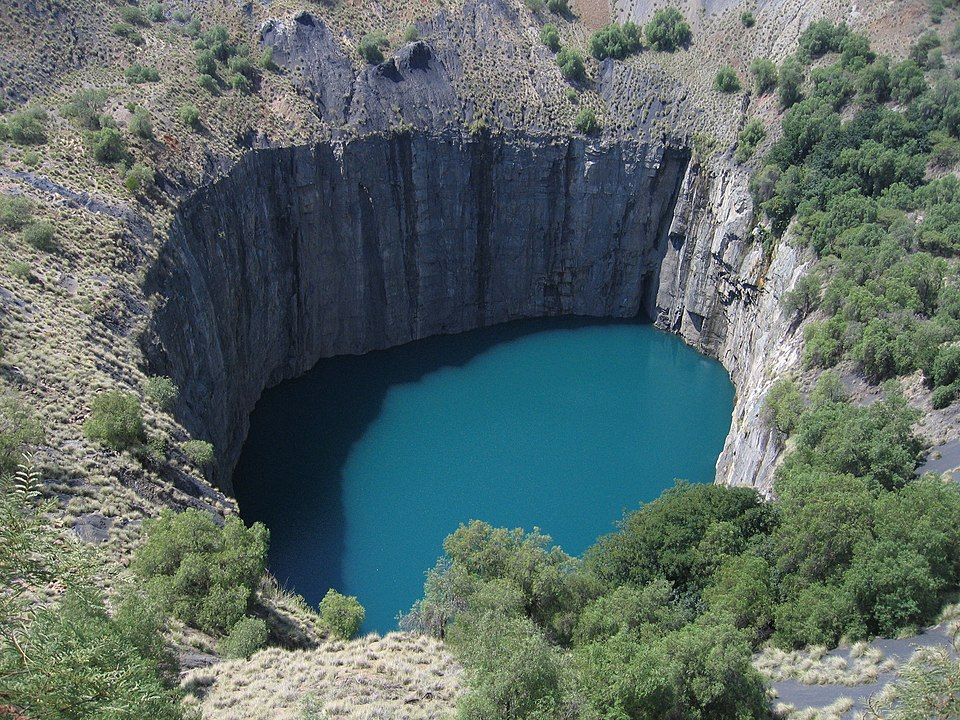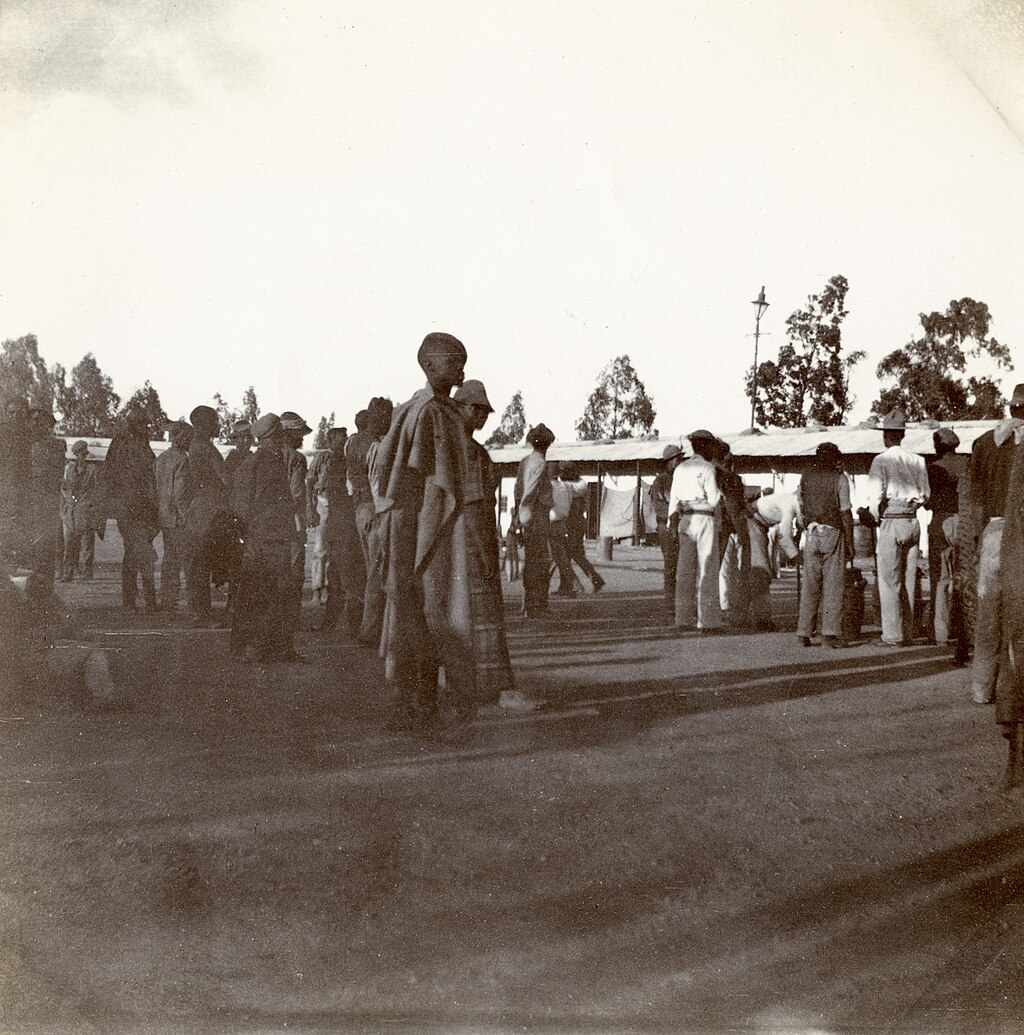IB Syllabus focus:
'Explore the political, social, and economic consequences of the discovery of diamonds and gold in South Africa.'
The finding of diamonds in 1867 near the Orange River followed by the gold rush in the Witwatersrand in 1886 revolutionised the economic, political, and social landscape of South Africa. These discoveries were catalytic in shaping the future of the nation and the broader southern African region.

This official geological survey map (1916) identifies the Witwatersrand gold field that underpinned South Africa’s late-nineteenth-century gold boom. While it includes specialist stratigraphic details not required by the syllabus, it clearly locates the main gold belt that drove urbanization, capital inflows, and industrialization. Source
Political Consequences
The Incitement of Colonial Interests
British Involvement: The British Empire, recognising the strategic importance and wealth potential, intensified its involvement in the region. This period also saw significant resistance movements such as the Mandinka resistance to French rule.
Colonial Administration: Administrative changes followed the annexations, with British colonial governance imposing its rule over the local Boer Republics.
The Shift in Geopolitical Dynamics
The Scramble for Africa: These discoveries contributed to the ‘Scramble for Africa’, with European powers vying for territorial control. This geopolitical struggle can be compared to the crisis of the Ancien Régime.
Boer-British Tensions: Rivalries escalated into the Anglo-Boer Wars, altering the power dynamics and leading to British dominance in the region.
Legislative and Tax Implications
Mining Laws: The government enacted laws to control mining operations, solidifying state authority over mineral resources.
Taxation Policies: New tax policies were implemented to benefit from the mining profits, which sometimes led to unrest among the local Boer population.
Infrastructural Developments
Railways and Ports: To facilitate the export of minerals, the British and colonial governments invested in major infrastructural projects.
Social Consequences
Urbanisation and Demographic Shift
Boomtowns: Mining towns like Kimberley and Johannesburg flourished, drastically altering the demographic landscape. The influx of workers and the formation of these towns can be compared to the social changes during the First World War.

The Big Hole at Kimberley—an open-pit mine created during the diamond rush—illustrates the scale and intensity of diamond extraction that transformed Kimberley into a boomtown. Its industrial footprint exemplifies the rapid urban growth and investment that followed the 1867 discoveries. Source
Population Growth: The promise of wealth led to a surge in population due to immigration from Europe and other regions of Africa.
The Formation of a Labour Market
Migrant Labour: A system of migrant labour was established, sourcing workers from rural areas across southern Africa.

Workers stand inside a company-run compound at Kimberley (c.1901), illustrating the regulated, single-sex accommodation that accompanied the growth of the mining economy. Such compounds restricted movement and normalized racial segregation in work and living spaces, anticipating later pass laws and apartheid-era controls. Source
Exploitative Conditions: The work was often dangerous and poorly paid, leading to exploitation and harsh living conditions for the workers.
Emergence of a Class Society
Social Stratification: A new class hierarchy emerged, with mine owners and businessmen at the top, and labourers at the bottom.
Racial Segregation: The wealth gap reinforced racial divisions, laying the groundwork for future apartheid policies, similar to the later apartheid legislation.
Economic Consequences
The Stimulation of the Mining Sector
Industrialisation: The mining sector became the cornerstone of South African industrialisation.
Economic Transformation: The agricultural economy began transforming into a more diversified and industrialised one.
Trade and Investment Boost
Export Economy: Gold and diamond exports became central to the South African economy, affecting international trade relations.
Capital Influx: Substantial British and international capital flowed into South Africa, leading to economic growth but also to a dependence on foreign investment.
Financial Sector Expansion
Banking and Finance: New financial services, including banks, emerged to support the mining industry and manage wealth.
Johannesburg Stock Exchange: The establishment of the stock exchange facilitated capital raising for mining and other ventures.
Impact on Indigenous Populations
Land and Displacement
Forced Removals: Indigenous peoples were forcibly removed from their lands to make way for mines, similar to the displacement seen during the Abyssinian crisis.
Loss of Livelihood: These communities faced the loss of their agricultural livelihoods and were often coerced into the mining labour market.
Cultural Disruption
Cultural Disintegration: The influx of foreigners and the establishment of mining towns led to the erosion of traditional cultures.
Social Upheaval: The social fabric of indigenous societies was disrupted, leading to long-term social issues.
Broader Implications
Economic Inequality and Segregation
Foundation for Apartheid: Early economic policies favoured whites, creating disparities that would be cemented by the later apartheid regime.
Segregation Policies: The segregation in the mines prefigured the state's apartheid policies, with pass laws controlling the movement of black workers.
Contribution to International Relations
Global Interest: South Africa's mineral wealth drew international interest, influencing foreign policy with major powers.
Strategic Importance: The region's wealth and strategic importance meant that South Africa became a significant player on the international stage.
Conclusion
The discovery of diamonds and gold in South Africa was not just a historical footnote but a turning point that set in motion a series of events with lasting consequences. The political realm was marked by colonial expansion and legislative changes aimed at securing control over the newfound wealth. Socially, the period saw significant urbanisation, the genesis of a racially stratified society, and the beginnings of systematic exploitation of indigenous populations. Economically, the discoveries catalysed industrialisation, facilitated the growth of a finance and banking sector, and increased the international monetary significance of the region.
These minerals, emblematic of wealth and desire, brought about profound transformations in South African society. They helped construct an economy that would become the most powerful on the continent but also laid the groundwork for future divisions and conflicts, the legacies of which continue to influence the country's socio-economic and political realities. The diamond and gold era, thus, can be seen as a crucial juncture, deeply embedded in the historical trajectory of South Africa.
FAQ
Foreign investment was crucial in the development of the South African mining industry. The capital-intensive nature of mining operations, particularly those extracting deep-level gold, required significant investment that local economies could not sustain. British and European investors provided the necessary funds, which helped to finance the construction of mining infrastructure, the import of machinery, and the recruitment of skilled labour. Companies such as De Beers consolidated smaller mining operations, thanks to foreign capital, enabling economies of scale and more efficient extraction methods. This influx of foreign capital also led to the establishment of the Johannesburg Stock Exchange in 1887, becoming the financial hub of Southern Africa.
Indigenous populations in South Africa employed various forms of resistance against the takeover of their lands during the mineral revolution. Initially, there were armed conflicts as communities tried to defend their territories against encroachment by both British and Boer settlers. The most notable were the Xhosa Wars and the Zulu War, which resulted in the defeat of these kingdoms and the annexation of their lands. Beyond physical conflict, there were also forms of passive resistance, including the non-cooperation with forced labour requirements and the establishment of communities on marginal lands that were less desirable to European settlers. However, the power imbalance and the technological and military superiority of the colonisers often overpowered these resistance efforts.
The environmental impact of the mining industry in South Africa was substantial and multifaceted. The landscape was radically altered as large swathes of land were excavated for mining operations. These activities resulted in soil erosion, deforestation, and the disruption of local ecosystems. Additionally, the mining process generated significant pollution, with water sources being contaminated by chemicals like cyanide and mercury used in gold processing. Air pollution from dust and the release of toxic gases also had detrimental effects on health and the environment. Furthermore, the industry’s demand for wood to support underground tunnels led to deforestation, and the growth of urban areas around mines strained local resources.
Cecil John Rhodes played a pivotal role in the South African diamond industry as an entrepreneur, mining magnate, and politician. He arrived in South Africa in 1870 and through a combination of ruthless business tactics and strategic consolidation, he eventually co-founded the De Beers Mining Company, which quickly established a monopoly over the diamond industry. Rhodes used his wealth and influence to extend British territory in Southern Africa, most notably by obtaining a royal charter for the British South Africa Company, which colonised much of modern-day Zimbabwe and Zambia. His legacy in the diamond industry is controversial, as he is both credited with its commercial success and critiqued for his imperialist practices and exploitation of African labour.
The discovery of diamonds and gold had a monumental influence on infrastructure development in South Africa. The need to transport heavy mining equipment to the mines and the extracted minerals to the coast for export necessitated the construction of an extensive railway network. Similarly, ports were expanded to handle the increased volume of exports and imports associated with the mining industry. The development of infrastructure was not limited to transportation; it also included the establishment of telegraph lines for communication and the construction of water and electrical supply systems to support the burgeoning mining towns. This development was uneven, however, as it primarily served the mining interests and their urban centres, often bypassing rural areas inhabited by the indigenous population.
Practice Questions
The discovery of diamonds and gold radically transformed the socio-economic structure of South Africa. Economically, it led to a shift from an agrarian economy to one dominated by industrial mining, attracting substantial foreign investment and creating immense wealth, particularly for the white minority. Socially, the wealth gap widened as a new class of mining magnates emerged, and the establishment of a migrant labour system facilitated urbanisation but also entrenched racial divisions. The exploitation of indigenous labour and the consequent social stratification laid the foundational structures for the institutionalised racial segregation that would later be legally enforced by the apartheid system.
The mineral revolution between 1880 and 1910 had profound political ramifications in South Africa. It intensified imperialistic competition, especially from Britain, resulting in the annexation of territories and leading to the Anglo-Boer Wars. Politically, it shifted the balance of power, with Britain eventually gaining control over the Boer Republics, a factor that would contribute to the Union of South Africa in 1910. This period also saw the implementation of mining laws and taxation policies, which were designed to assert control over the lucrative industry. Furthermore, the wealth generated from mining underpinned the development of infrastructure and institutionalised the British influence on the region’s politics.

